by Judy Gonyeau, managing editor
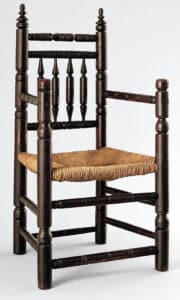
Everyone has their favorite chair, whether it is an ergonomic masterpiece or an overstuffed recliner. Even our pets tend to own their spots when allowed on the furniture.
Across the centuries of our ever-changing country, American furniture was not only influenced by other countries, but by purpose, comfort, status, and things that were pleasing to the eye within the decor of the household. While some may give a chair a passing glance, others admire the lines, decorative elements, and structure, along with the history and provenance placed before them on four, and sometimes three, legs.
Early American Seating

The European settlers coming to North America had very little furniture to place in the home – just the basics. Each piece was handmade with only a very few pieces that could be purchased by fellow immigrants. Early Americans made and used furniture that was inspired by the memories of those pieces in their European homes. Jacobean style chairs with heavy carving and sturdily built, but lacking a certain finesse that comes from having the right tools and skills meant these chairs were rough in character and a bit simpler in design. And as for comfort, that was not necessarily the goal in these times.
The Wainscot chairs kept all the decorations to the front with simple squared supporting wood elements toward the back. Other chairs, referred to as Turned chairs, were more Elizabethan in nature and also referred to as Spindle chairs.
Colonial / William and Mary / Queen Anne
Makers still turned to England for style ideas as towns and cities were being established in the New World, and a simplified version of their cousin’s decor began to take on a more “American” look. The woods used were elm, walnut, and mahogany. Better and more intricate construction was starting to show up, including the use of dovetails. Finishing meant applying paint, oil varnish, or a layer of wax.
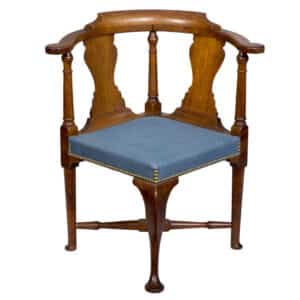
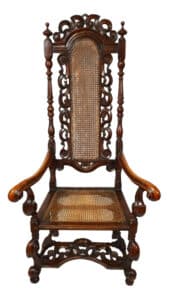
Within the realm of Colonial furniture came other influences of design and structure which include the William and Mary (W&M) style, and the Queen Anne Style. W&M-style chairs had an emphasis on the purpose of the piece. Strong, high-relief carving and curves with different woods are used to create different tones or colors. W&M trended from 1710-1735 in America, ten years longer than in England.
The Queen Anne style could be considered the “smaller, lighter, and more comfortable” relation to William and Mary. You need go no further than Independence Hall in Philadelphia to see fine examples on display that are attributed to William Savery. Dates for the Queen Anne trend run from the mid-1720s to around 1760.
Pennsylvania Dutch Chairs
The heavy immigration of German people to American shores starting in the late 1600s brought another set of skills and aesthetics to this growing country. The true heyday of the Pennsylvania Dutch style took place from 1730 to about 1830. According to Study.com, “They brought German woodworking techniques with them, but also began to incorporate techniques and styles found in nearby English colonies. Ultimately, Pennsylvania Dutch furniture represented a distinct interpretation of many other styles popular in Europe, and the colonies throughout this time, all created foremost with a focus on utility. … it was more important for things to be practical than stylish. Pennsylvania Dutch furniture was noted for its stability and longevity.”
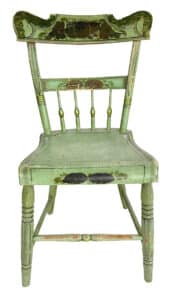
As you can see with the circa 1820-30 chair, the chair is embellished to a level that is decorative without being overtly ostentatious.
Chippendale – Real Chippendale
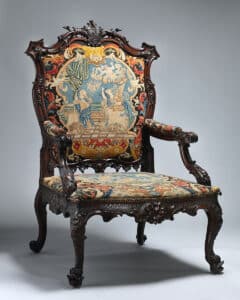
Thomas Chippendale’s design for this “French Chair,” published in The Gentleman and Cabinet-Maker’s Director (1754), specified that it “must be covered with Tapestry, or other sort of Needlework.” Here, the needlework depicts a scene of the Annunciation, the feast day when contracts for trades and craftspeople were renegotiated. photo: The Met
Dating between 1755 and 1780, the Chippendale chair brought the best of the Queen Anne style and added a more refined and delicate look to the furniture.
According to christies.com, “many of the pieces were based on the designs in Thomas Chippendale’s The Gentleman and Cabinet-Maker’s Director, first published in England in 1754.
“The style combined decorative elements from three distinct sources: French Rococo, Chinese ornamentation, and Gothic architectural details. Overall, Chippendale is characterized by a profusion of carving, predominantly on mahogany, with features including acanthus—an ornament resembling foliage—opposing ‘C’ scrolls, and ruffled, rocaille motifs on the splat (the central support panel of a chair back), knees and skirts (or horizontal façades) of chairs and case pieces, which frequently sit on ball-and-claw feet.”
Many makers of this furniture were living and working in the Philadelphia area, including Thomas Affleck, Benjamin Randolph, and Henry Clifton. Carvers who had the hand to create all those scrolls included John Pollard and Nicholas Bernard, among others.
Being able to discern a “real” Chippendale from others could mean a great deal when it comes to value. Things to be aware of include his use of cross-grain wood when working with mahogany, concealed screw holes that tell how chairs were transported, and the positioning of the arms, among others. The best route to take is to consult a professional.
Shaker Chairs (1820-1860)
Just as Chippendale chairs involved incredibly intricate design elements, the Shakers and other communities like them worked to keep things simple with clean lines, but makers paid no less attention to detail and careful craftsmanship than other furniture makers.

As noted in the September 2022 issue of the Journal (“Shaker Life”), the goal was to create a chair with minimal ornamentation or decoration. Shaker ladder- back chairs were also customized to fit the sitter or community member. The overall profile of the chairs remained adherent to the style guidelines shared among the Shakers.
Each element of the chair was made to be useful. The finials made the chair easy to move. The wood used and its construction made them lightweight and easy to handle. Chair legs were smooth so they could be picked up and hung on the wall – upside down so the seat would not accumulate too much dust.
Shakers did not dismiss modern machinery when making their chairs. At Mount Lebanon, where they made chairs to sell to the public, the craftsmen often used steam-powered lathes, circular saws, and other mechanical devices to achieve the perfection of these ingenious chairs. Their popularity then and even now has resulted in fakes being made to take advantage of the market, so it is important to meet with an expert when making a purchase.
The Age of Hitchcock & The “Fancy” Chairs
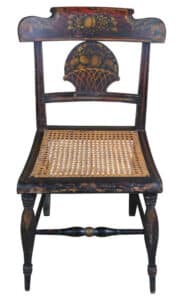
selling for $450 online.
In an article posted at connecticuthistory.org, author Anne Guernsey refers to a craze happening in the 1800s as the age of “fancy” chairs as kicked off by Lambert Hitchcock (1795-1852). These days were filled with more entertaining at the home as well as taking “callers” into the home and establishing the members of the household on the social ladder. “During the second quarter of the 19th century, ‘fancy chairs’ were all the rage for middle-class American parlors and dining rooms.” Comfortable, attractive, well-made seating became more important within an attractive home.
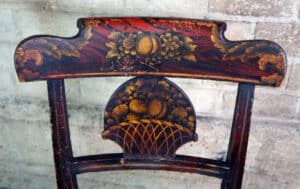
Making such highly decorated chairs that were often customized using a variety of decorative stencils made the Hitchcock chairs very time consuming. Using his manufacturing ingenuity, Hitchcock increased production speed and output by developing a line of interchangeable chair parts. According to the Connecticut History article, “Hitchcock manufactured all types of furniture: adult straight chairs and armchairs, smaller chairs for children, long benches with detachable front rails called ‘Cape Cod Rockers’ or, invoking a then more common stereotype, ‘Mammy Benches.’
His furniture was inexpensive and beautifully decorated with stencils filled in with oil paint or inexpensive metallic powder. Men made the chairs, children painted them, and women applied the stencils.” Hitchcock went bankrupt more than once and had more liabilities than assets at his death in 1852. In the 1940s, John Tarrant Kenney started the Hitchcock Chair Company in Riverton, CT, and made Hitchcock chairs until 2006. Recently, antique dealers Rick Swenson and Gary Hath from New Hartford, CT, invested and are once again bringing back these ageless traditional chairs.
American Furniture in the Victorian Era
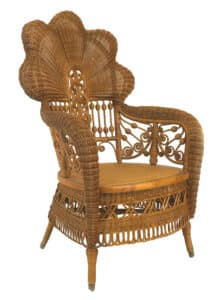
It is no surprise that American furniture of the Victorian era was obviously heavily influenced by the phenomenon of Queen Victoria and her influence over the style of almost everything in her kingdom. The furniture was ornate, with craftsmen and women striving to achieve perfection in design, manufacturing, and in upgrading the world of upholstery to include needlepoint, silks, velvet, and the use of tufting and draping.
Status in England weighed heavy on the minds of those in the upper tiers of social status. The more ornate, the better. Mahogany was the order of the day, with walnut being used for smaller pieces.
For other wood, fancy Flame Mahogany veneers were applied to other woods to give the look of the times without the expense. Inlay of rosewood and other specialty woods such as cherry, birch, and maple would be brought to a high shine, making intricate designs possible. The timeline of this design period went from 1840 to 1910.
Victorian furniture was the first furniture style to be mass-produced. According to the blog at newel.com, “During the Victorian era, furniture manufacturing shifted largely from hand-made to machine-made, making it far more accessible, and because of this, Victorian Furniture was an all-encompassing genre that included all types of furniture, from chairs, settees, and sofas to end tables, coffee tables, beds, and case goods.”
When it came to seating, American Victorian design was on full display indoors as well as outdoors. The use of painted metal formed into delicate shapes, wicker bent into fanciful ornamentation, or bringing setees and rockers into nature made the Victorian lifestyle complete when entertaining, reading, or just relaxing in the shade.
A chair’s design elements were often the result of other influences of trending ideas taken to their highest form. As noted by Newel, “Victorian Furniture cannot be identified by its style of legs or feet, as it drew upon influences from many other styles. For this reason, it can be said that Victorian, itself, is not a style but a period.”
Mission Furniture/Arts & Crafts
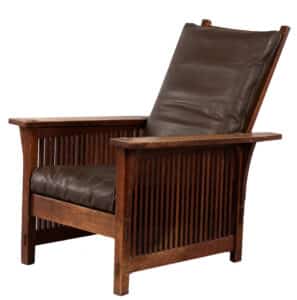
And to think this design movement started with a chair.
In around 1894, AJ Forbes made a solid wood chair for San Francisco’s Swedenborgian Church. It was anything but Victorian. This handcrafted chair featured a simple, straight-line construction with a comfortable seat and was built to last. Joseph P. McHugh was a furniture maker and retailer in New York who knew a good thing when he saw it – and copied it. McHugh called the style “Mission” to reference the many Spanish missions in California, although it had little to do with them.
In 1901, Mission furniture made an impact at the Pan-American Exposition in Buffalo, New York, as people were looking to simplify their furniture choices after the heavily-manufactured Victorian movement during the Industrial Revolution. A return to hand-craftsmanship was in order. Gustav Stickley (1858-1842) referred to the style as “Arts and Crafts” after noting the “Mission” name was misleading. While the Arts & Crafts era was started in England, Stickley, along with others including Charles Rohlfs (1853-1936), and Arthur J. Stone (1847-1938), an immigrant from England, focused on man-made items, not machine-made.
Characteristics of Arts & Crafts chairs and furniture include:
• Handcrafted from oak or quarter-sawn white oak.
• Simple, straight-line construction.
• Often features a medium or dark stain.
• Heavy and substantial, but well proportioned.
• Absence of ornamentation.
• Functional and durable.
• Emphasis on simple horizontal and vertical lines, and flat panels accentuate the grain of the wood.
Post-War/Mid-Century Modern
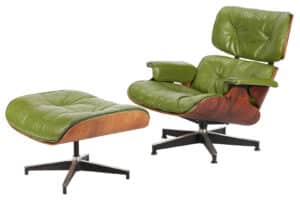
After suffering through the two World Wars and the Great Depression, it was time for America to focus on a bright, modern future. Inexpensive housing and everything that goes in it meant a return to manufacturing cheaper options for this new lifestyle.
According to an essay by Jared Goss at metmuseum.org, “The elaborate households of the prewar years were gone … Gone, too, was the conventional approach to furnishings as expensive and permanent status objects.”
Designers from across the globe, including Finn Juhl and Eero Saarinen, to Americans Harry Bertoia, Frank Lloyd Wright, and Charles and Ray Eames reveled in all things new – new lines, new materials, sleek functionality, forms that went in all directions, and new color.
There is a wide variety of designs made over the years for Americans to take a load off. This can make anyone want to collect more than just one, so try a couple out. Settle in for a good read or a bit of work. Take a seat – or two.





Related posts: